Analysis of Measurement and Recognition of Asset Impairment in Finance
VerifiedAdded on 2020/05/28
|7
|1645
|44
Report
AI Summary
This report delves into the critical aspects of asset impairment, a crucial concept in financial accounting. It meticulously examines the process of assessing and recognizing asset impairment, focusing on the determination of recoverable amounts and carrying amounts. The report outlines the conditions that trigger impairment assessments, including both external and internal indicators, and details the calculation of impairment losses. It explains the allocation of impairment losses, particularly concerning goodwill and other assets within a cash-generating unit (CGU), and provides illustrative journal entries to demonstrate the accounting treatment. The report also covers the reversal of impairment losses, emphasizing the limitations and conditions associated with such reversals. Furthermore, the report highlights the importance of asset impairment in reflecting the true economic value of assets and its impact on financial statements. The report includes references to relevant accounting standards and provides a comprehensive understanding of asset impairment accounting.
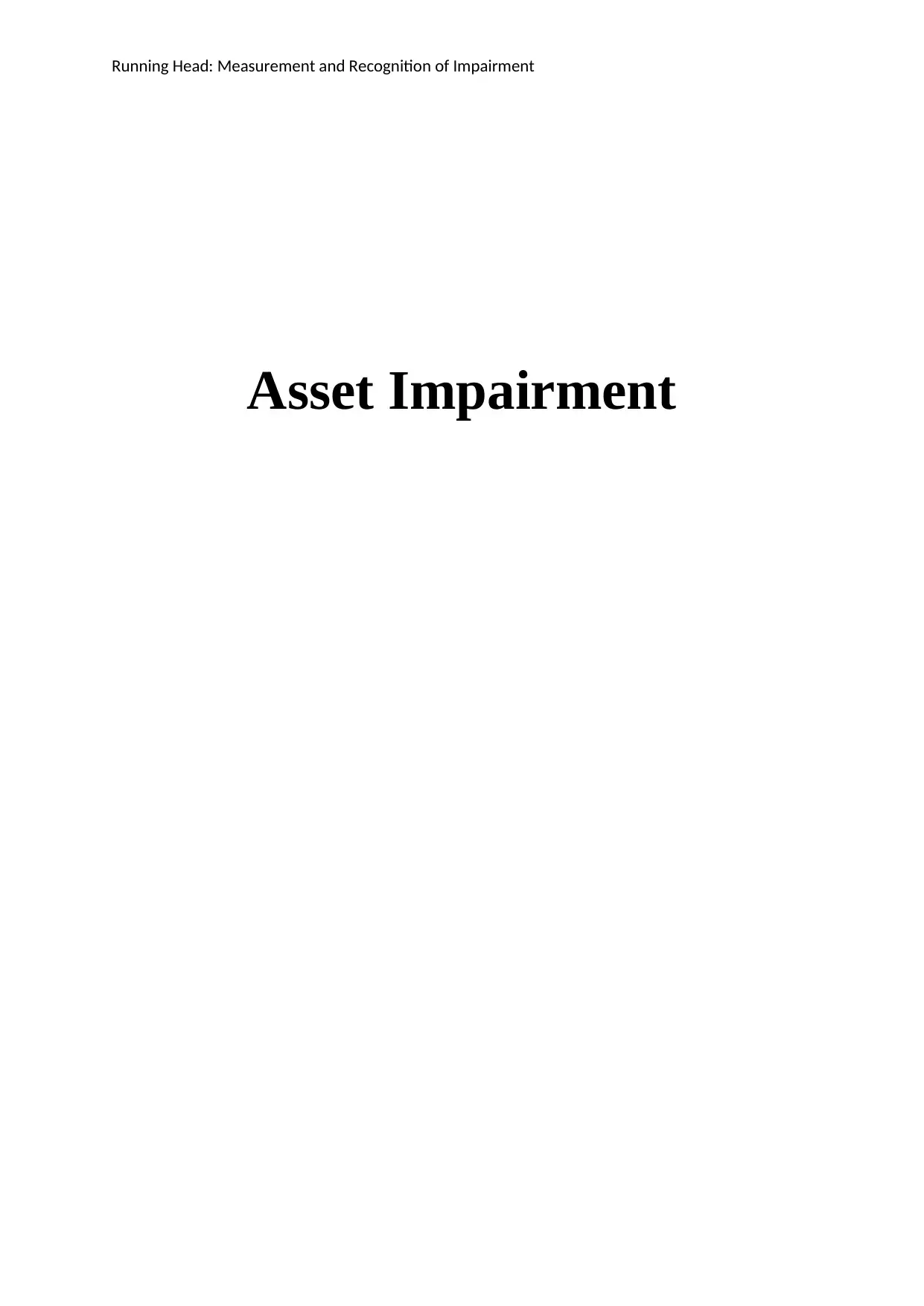
Running Head: Measurement and Recognition of Impairment
Asset Impairment
Asset Impairment
Paraphrase This Document
Need a fresh take? Get an instant paraphrase of this document with our AI Paraphraser
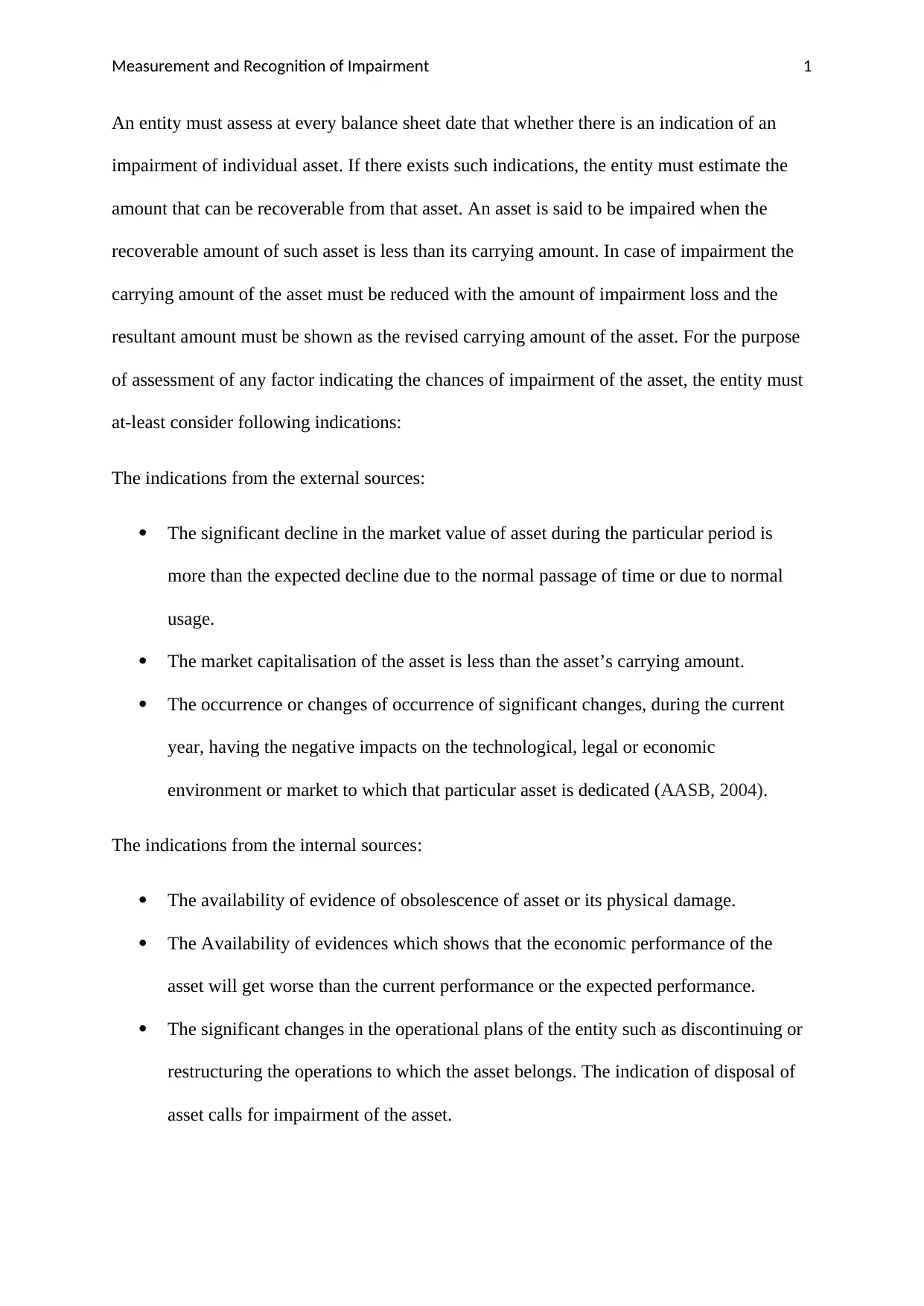
Measurement and Recognition of Impairment 1
An entity must assess at every balance sheet date that whether there is an indication of an
impairment of individual asset. If there exists such indications, the entity must estimate the
amount that can be recoverable from that asset. An asset is said to be impaired when the
recoverable amount of such asset is less than its carrying amount. In case of impairment the
carrying amount of the asset must be reduced with the amount of impairment loss and the
resultant amount must be shown as the revised carrying amount of the asset. For the purpose
of assessment of any factor indicating the chances of impairment of the asset, the entity must
at-least consider following indications:
The indications from the external sources:
The significant decline in the market value of asset during the particular period is
more than the expected decline due to the normal passage of time or due to normal
usage.
The market capitalisation of the asset is less than the asset’s carrying amount.
The occurrence or changes of occurrence of significant changes, during the current
year, having the negative impacts on the technological, legal or economic
environment or market to which that particular asset is dedicated (AASB, 2004).
The indications from the internal sources:
The availability of evidence of obsolescence of asset or its physical damage.
The Availability of evidences which shows that the economic performance of the
asset will get worse than the current performance or the expected performance.
The significant changes in the operational plans of the entity such as discontinuing or
restructuring the operations to which the asset belongs. The indication of disposal of
asset calls for impairment of the asset.
An entity must assess at every balance sheet date that whether there is an indication of an
impairment of individual asset. If there exists such indications, the entity must estimate the
amount that can be recoverable from that asset. An asset is said to be impaired when the
recoverable amount of such asset is less than its carrying amount. In case of impairment the
carrying amount of the asset must be reduced with the amount of impairment loss and the
resultant amount must be shown as the revised carrying amount of the asset. For the purpose
of assessment of any factor indicating the chances of impairment of the asset, the entity must
at-least consider following indications:
The indications from the external sources:
The significant decline in the market value of asset during the particular period is
more than the expected decline due to the normal passage of time or due to normal
usage.
The market capitalisation of the asset is less than the asset’s carrying amount.
The occurrence or changes of occurrence of significant changes, during the current
year, having the negative impacts on the technological, legal or economic
environment or market to which that particular asset is dedicated (AASB, 2004).
The indications from the internal sources:
The availability of evidence of obsolescence of asset or its physical damage.
The Availability of evidences which shows that the economic performance of the
asset will get worse than the current performance or the expected performance.
The significant changes in the operational plans of the entity such as discontinuing or
restructuring the operations to which the asset belongs. The indication of disposal of
asset calls for impairment of the asset.

Measurement and Recognition of Impairment 2
The recoverable amount of an individual asset is determined as the higher of the two
values i.e. the fair value of the asset net of selling expenses or the value in use of that
particular asset (Hsieh & Wu, 2005).
Impairment loss in case of individual asset is recognised in the statement of financial
performance of the entity only if the carrying amount of that asset exceeds the amount that
asset is capable of recovering from the market through its sale. However, in the
circumstances where carrying amount is lower than the recoverable amount of the asset, no
accounting adjustment is required to be made (Ernst & Young, 2010). Hence, the difference
of the recoverable amount and carrying amount is ignored in such cases. The loss of
impairment has to be recognised immediately in the statement of profit and loss account.
However, if the asset had been previously revalued and carries the credit balance in the
revaluation account then the impairment loss on that specific asset must be taken to
revaluation amount. But, if the surplus carried in the revaluation account of the asset is less
than the total amount of impairment loss on that asset, then only that much of impairment
loss of the asset will be charged to revaluation reserve as much of amount is available in the
revaluation account and the excess depreciation is then charged to the profit and loss account
(Reinstein & Lander, 2004).
The impairment loss is measured by deducting the recoverable amount of the asset from its
carrying amount. The carrying amount of the asset is the value that is being carried by it in
the statement of financial position (balance sheet) of the entity (AASB 136, 2009). Whereas,
the recoverable amount of an asset is determined as the higher of the two values i.e. the value
in use of the asset or the net selling price of that asset. Value in use of the asset is ascertained
by aggregating the present values of all the estimated cash flows from the continuous use of
the asset or from its disposal. The cash flows are firstly estimated and then the discounting
rate of return is applied to such cash flows to determine the total present value of the cash
The recoverable amount of an individual asset is determined as the higher of the two
values i.e. the fair value of the asset net of selling expenses or the value in use of that
particular asset (Hsieh & Wu, 2005).
Impairment loss in case of individual asset is recognised in the statement of financial
performance of the entity only if the carrying amount of that asset exceeds the amount that
asset is capable of recovering from the market through its sale. However, in the
circumstances where carrying amount is lower than the recoverable amount of the asset, no
accounting adjustment is required to be made (Ernst & Young, 2010). Hence, the difference
of the recoverable amount and carrying amount is ignored in such cases. The loss of
impairment has to be recognised immediately in the statement of profit and loss account.
However, if the asset had been previously revalued and carries the credit balance in the
revaluation account then the impairment loss on that specific asset must be taken to
revaluation amount. But, if the surplus carried in the revaluation account of the asset is less
than the total amount of impairment loss on that asset, then only that much of impairment
loss of the asset will be charged to revaluation reserve as much of amount is available in the
revaluation account and the excess depreciation is then charged to the profit and loss account
(Reinstein & Lander, 2004).
The impairment loss is measured by deducting the recoverable amount of the asset from its
carrying amount. The carrying amount of the asset is the value that is being carried by it in
the statement of financial position (balance sheet) of the entity (AASB 136, 2009). Whereas,
the recoverable amount of an asset is determined as the higher of the two values i.e. the value
in use of the asset or the net selling price of that asset. Value in use of the asset is ascertained
by aggregating the present values of all the estimated cash flows from the continuous use of
the asset or from its disposal. The cash flows are firstly estimated and then the discounting
rate of return is applied to such cash flows to determine the total present value of the cash
⊘ This is a preview!⊘
Do you want full access?
Subscribe today to unlock all pages.

Trusted by 1+ million students worldwide

Measurement and Recognition of Impairment 3
flows related to the asset. This value in use is then compared with the net selling price of the
asset. Net selling price of the asset is the value that can be obtained from the sale of the
particular asset in the market in the arm’s length transaction that can be taken place between
the parties that are knowledgeable and willing. This obtainable price must be netted off of
any expenses incurred in selling the asset (IFRS, 2017).
The impairment loss of an asset can be reversed in the year in which the recoverable amount
of asset exceeds its carrying amount. Such reversal of the impairment must be recognised in
the profit and loss account immediately as the income (Chen, Wang & Zhao, 2007).
However, if the impairment loss was charged to the revaluation account previously, then such
income from reversal of impairment loss must also be recognised in the revaluation reserve
by way of writing back of the loss earlier recognised and even after writing back of entire
impairment loss, there remains any balance of reversal of impairment loss, then such surplus
will be shown as revenue. But, in no case the revised carrying amount (increased value) due
to the reversal of impairment shall not be greater than the carrying amount which would have
been identified (net of depreciation or the amortisation) had there been no impairment loss
recognised in the previous accounting years. Moreover, after reversing the impairment loss,
the depreciation or the amortisation charges must be readjusted for the future periods so as to
allocate the revised carrying amount of that asset net of its residual value, if any, on the
rational basis over the useful life of the asset that is remained.
Impairment is therefore considered as the loss in the value of asset which must be recorded as
and when it is recognised by the firm. Since, the impact of the impairment can be significant
enough to affect the financial position of the company, the impairment test must be
conducted on the immediate basis whenever there is/ are some indications of asset
impairment is available.
flows related to the asset. This value in use is then compared with the net selling price of the
asset. Net selling price of the asset is the value that can be obtained from the sale of the
particular asset in the market in the arm’s length transaction that can be taken place between
the parties that are knowledgeable and willing. This obtainable price must be netted off of
any expenses incurred in selling the asset (IFRS, 2017).
The impairment loss of an asset can be reversed in the year in which the recoverable amount
of asset exceeds its carrying amount. Such reversal of the impairment must be recognised in
the profit and loss account immediately as the income (Chen, Wang & Zhao, 2007).
However, if the impairment loss was charged to the revaluation account previously, then such
income from reversal of impairment loss must also be recognised in the revaluation reserve
by way of writing back of the loss earlier recognised and even after writing back of entire
impairment loss, there remains any balance of reversal of impairment loss, then such surplus
will be shown as revenue. But, in no case the revised carrying amount (increased value) due
to the reversal of impairment shall not be greater than the carrying amount which would have
been identified (net of depreciation or the amortisation) had there been no impairment loss
recognised in the previous accounting years. Moreover, after reversing the impairment loss,
the depreciation or the amortisation charges must be readjusted for the future periods so as to
allocate the revised carrying amount of that asset net of its residual value, if any, on the
rational basis over the useful life of the asset that is remained.
Impairment is therefore considered as the loss in the value of asset which must be recorded as
and when it is recognised by the firm. Since, the impact of the impairment can be significant
enough to affect the financial position of the company, the impairment test must be
conducted on the immediate basis whenever there is/ are some indications of asset
impairment is available.
Paraphrase This Document
Need a fresh take? Get an instant paraphrase of this document with our AI Paraphraser
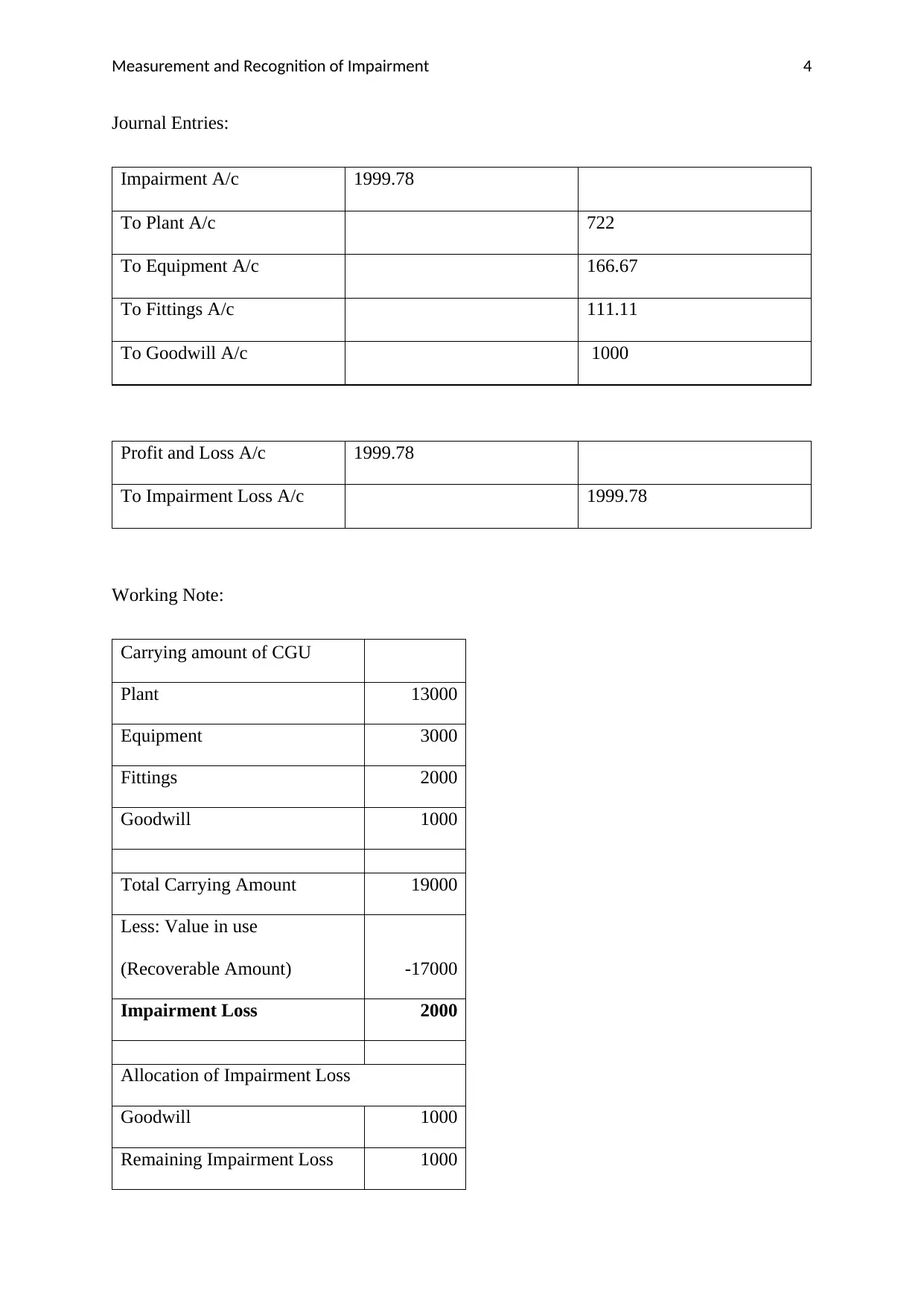
Measurement and Recognition of Impairment 4
Journal Entries:
Impairment A/c 1999.78
To Plant A/c 722
To Equipment A/c 166.67
To Fittings A/c 111.11
To Goodwill A/c 1000
Profit and Loss A/c 1999.78
To Impairment Loss A/c 1999.78
Working Note:
Carrying amount of CGU
Plant 13000
Equipment 3000
Fittings 2000
Goodwill 1000
Total Carrying Amount 19000
Less: Value in use
(Recoverable Amount) -17000
Impairment Loss 2000
Allocation of Impairment Loss
Goodwill 1000
Remaining Impairment Loss 1000
Journal Entries:
Impairment A/c 1999.78
To Plant A/c 722
To Equipment A/c 166.67
To Fittings A/c 111.11
To Goodwill A/c 1000
Profit and Loss A/c 1999.78
To Impairment Loss A/c 1999.78
Working Note:
Carrying amount of CGU
Plant 13000
Equipment 3000
Fittings 2000
Goodwill 1000
Total Carrying Amount 19000
Less: Value in use
(Recoverable Amount) -17000
Impairment Loss 2000
Allocation of Impairment Loss
Goodwill 1000
Remaining Impairment Loss 1000
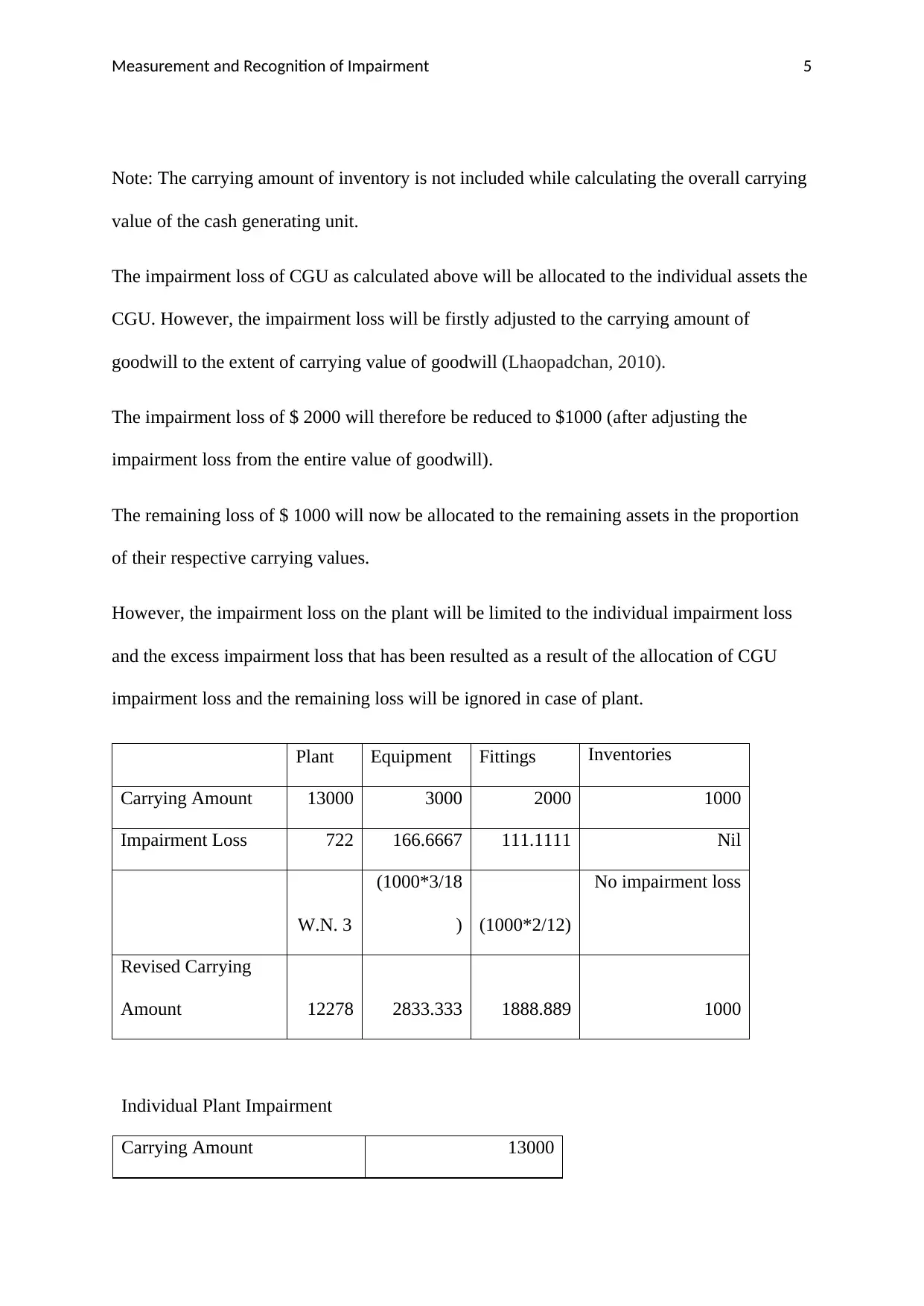
Measurement and Recognition of Impairment 5
Note: The carrying amount of inventory is not included while calculating the overall carrying
value of the cash generating unit.
The impairment loss of CGU as calculated above will be allocated to the individual assets the
CGU. However, the impairment loss will be firstly adjusted to the carrying amount of
goodwill to the extent of carrying value of goodwill (Lhaopadchan, 2010).
The impairment loss of $ 2000 will therefore be reduced to $1000 (after adjusting the
impairment loss from the entire value of goodwill).
The remaining loss of $ 1000 will now be allocated to the remaining assets in the proportion
of their respective carrying values.
However, the impairment loss on the plant will be limited to the individual impairment loss
and the excess impairment loss that has been resulted as a result of the allocation of CGU
impairment loss and the remaining loss will be ignored in case of plant.
Plant Equipment Fittings Inventories
Carrying Amount 13000 3000 2000 1000
Impairment Loss 722 166.6667 111.1111 Nil
W.N. 3
(1000*3/18
) (1000*2/12)
No impairment loss
Revised Carrying
Amount 12278 2833.333 1888.889 1000
Individual Plant Impairment
Carrying Amount 13000
Note: The carrying amount of inventory is not included while calculating the overall carrying
value of the cash generating unit.
The impairment loss of CGU as calculated above will be allocated to the individual assets the
CGU. However, the impairment loss will be firstly adjusted to the carrying amount of
goodwill to the extent of carrying value of goodwill (Lhaopadchan, 2010).
The impairment loss of $ 2000 will therefore be reduced to $1000 (after adjusting the
impairment loss from the entire value of goodwill).
The remaining loss of $ 1000 will now be allocated to the remaining assets in the proportion
of their respective carrying values.
However, the impairment loss on the plant will be limited to the individual impairment loss
and the excess impairment loss that has been resulted as a result of the allocation of CGU
impairment loss and the remaining loss will be ignored in case of plant.
Plant Equipment Fittings Inventories
Carrying Amount 13000 3000 2000 1000
Impairment Loss 722 166.6667 111.1111 Nil
W.N. 3
(1000*3/18
) (1000*2/12)
No impairment loss
Revised Carrying
Amount 12278 2833.333 1888.889 1000
Individual Plant Impairment
Carrying Amount 13000
⊘ This is a preview!⊘
Do you want full access?
Subscribe today to unlock all pages.

Trusted by 1+ million students worldwide
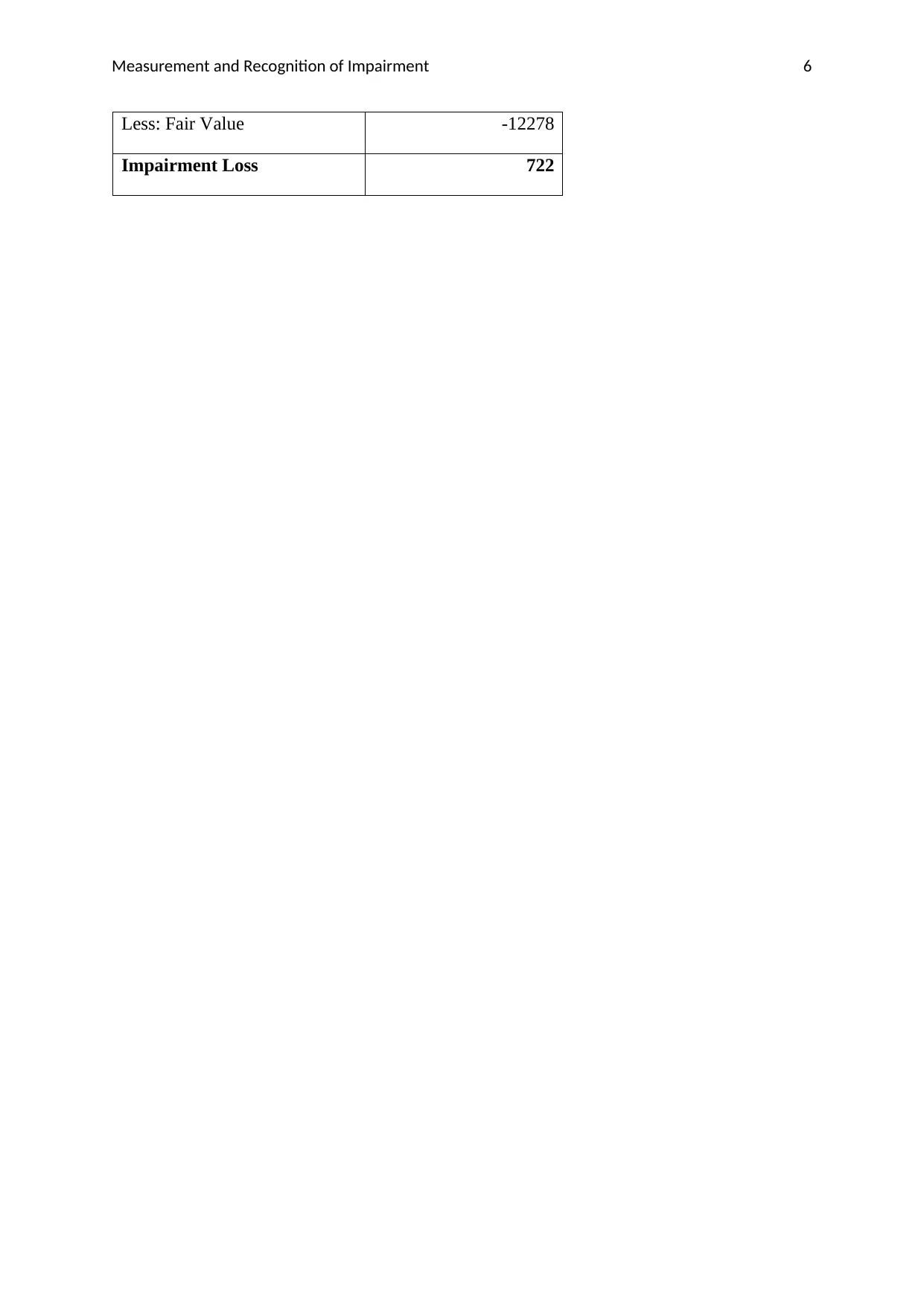
Measurement and Recognition of Impairment 6
Less: Fair Value -12278
Impairment Loss 722
Less: Fair Value -12278
Impairment Loss 722
1 out of 7
Related Documents
Your All-in-One AI-Powered Toolkit for Academic Success.
+13062052269
info@desklib.com
Available 24*7 on WhatsApp / Email
![[object Object]](/_next/static/media/star-bottom.7253800d.svg)
Unlock your academic potential
Copyright © 2020–2025 A2Z Services. All Rights Reserved. Developed and managed by ZUCOL.





